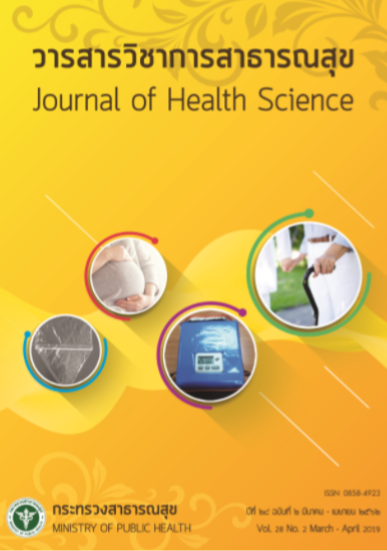Community Participation and Network Partners in the Development of Solid Waste Management Systems, Atsamat Municipality, Atsamat District, Roi Et Province
Keywords:
garbage disposal, participation, parties to the networkAbstract
The aims of the participatory action research were to develop a solid waste management system with the participation of the community and partners. It was conducted during January 2015 - April 2017 among the study population in 5 villages of Atsamat Municipality, altogether 1,236 households. The Phase 1 assessed the context and situation on solid waste management in the communities; the Phase 2 involved data sharing, workplan development, and implementation of the plan; and followed by the Phase 3, monitoring and evaluation. Data were collected by documents review, in-depth interview, focus group discussion, and participatory and non-participatory observation. Content analysis and descriptive statistics were used for data analysis. It was found that the amount of solid waste in Atsamat Municipality around 5,000 kilogram per day; and was handled daily by 8 garbage collectors with 2 garbage trucks. There was no sorting of the garbage items; and the hugh amount of them were overflowly dumped in waste pond creating the need to burn them. As a result, the nearby communities were overwhelmed with dust and bad smell. After the data sharing which resulted in awareness on the need for proper waste management, the communities and developmental partners had jointly developed a management plan which incorporated the interventions such as the establishment of a recycling gabage bank project, bio-fermented solution, announcement of non-waste village policy, the re-use of wasted materials, management of hazardous waste, and the procurement incinerator by the municipality. Such community movement had initiated significant changes in the people as observed by the sorting of gabage items before disposal, the continuation of garbage bank of which the generated income was utilized for welfare activities. The communites became study sites on garbage management, and the municipality received a certificate of environmental health accreditation (EHA) in solid waste management. Thus, it would be essential to create public awareness on the problem of solid waste in the community, and initiate their own need to address the problem. At the same time, technical advices from development partners and funding support from local authorities would be necessary to contribute to the successful management of the problem in order to attain continuity and sustainability of the operations.
Downloads
Downloads
Published
How to Cite
Issue
Section
License
Copyright (c) 2019 Journal of Health Science - วารสารวิชาการสาธารณสุข

This work is licensed under a Creative Commons Attribution-NonCommercial-NoDerivatives 4.0 International License.







